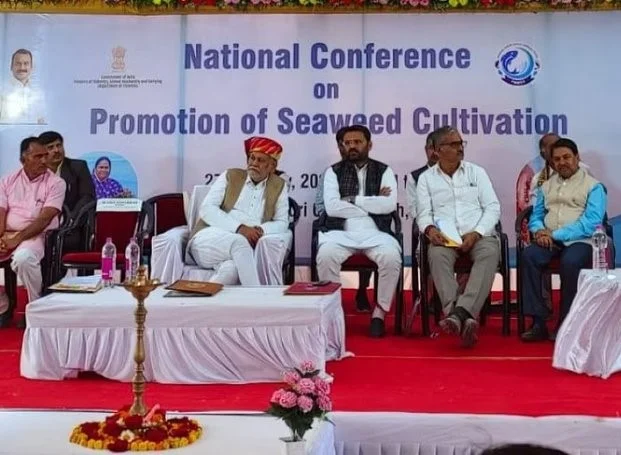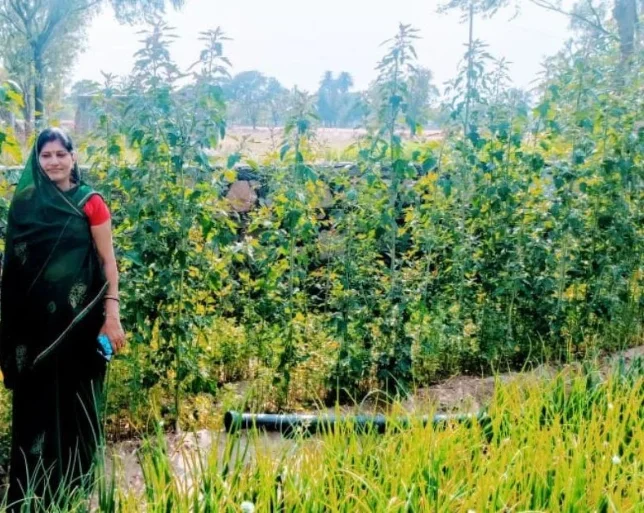Staying committed to an art form often comes with a cost for the artist. This is the sentiment of 48-year-old V. Gopi Raju, a fifth-generation artist specializing in Thanjavur paintings. Despite the influx of cheaper imitations in the market, Raju remains dedicated to preserving the traditional techniques and materials passed down by his ancestors.
Thanjavur, also known as Tanjore, is a district on the east coast of Tamil Nadu, nestled on the fertile plains of the Cauvery River. Recognized as the rice bowl of the state, it gained renown for its vibrant gold-plated paintings, once favored by the Chola, Nayaka, and Maratha rulers since as far back as 1600 AD.
“I’m passing on the art form to my son, but I don’t want him to pursue it as a profession,” shares Raju over the phone. Raju’s father, T. Venkatesa Raja, is a well-known artist who received the prestigious Shilp Guru award, the highest recognition in the Indian handicrafts sector, presented by the President in 2015.
In 2006, this art form secured a spot in India’s geographical indication (GI) registry. The GI designation aims to recognize and safeguard products—whether agricultural, natural, or manufactured—that originate from a specific geographical area. The primary goal is to prevent unauthorized use, enhance global sales, and contribute to the economic well-being of producers. A product with a GI tag is also intended to serve as an indicator of its quality and reputation.
However, as per Raju, the GI certification for Thanjavur paintings has provided little practical benefit beyond acknowledging the cultural significance of the art. These paintings are priced at a minimum of ₹6,000 and can go up to ₹25 lakh per piece, varying based on size and craftsmanship. Raju points out, “Many artists now opt for cheaper materials to reduce costs. Unfortunately, there’s no monitoring or quality check to distinguish a fake from an original. Even government emporiums are selling these imitation paintings.”
Up until the end of November, the office of the Controller General of Patents, Designs, and Trademarks under the central commerce ministry has granted GI tags to 496 products. More additions are in the pipeline, covering various items such as agricultural products like litchis from Bihar, hand-embroidered garments like Lucknow chikan, and food preparations like Bikaneri bhujia, a savory snack from Rajasthan.
However, the destiny of most of these products isn’t significantly different from that of Thanjavur paintings. While the registrations serve as a documentation of India’s rich cultural and agricultural heritage, they often fail to translate into improved economic prospects for the producers. Only a handful of products manage to make a mark globally, such as Basmati rice, Alphonso mangoes from coastal Maharashtra, and Darjeeling tea from West Bengal. This contrasts with the success stories of globally recognized products like Tequila from Mexico, coffee from Colombia, and Scotch whiskey from the UK.

Unnat Pandit, the controller general at India’s patent office, explains that the purpose behind GI registrations is to empower communities and safeguard their collective intellectual property. Pandit emphasizes that the next phase in this journey aims at creating sustainable livelihoods and exploring global opportunities.
“India has enormous potential and can include approximately 15,000 products in its GI registry. The registration of products like Pashmina shawl and saffron (from Kashmir), Morena gajak (a dessert from Madhya Pradesh), and textile items like Banarasi silk (from Uttar Pradesh) has proven beneficial for producer groups by expanding the market and commanding a premium price,” notes Pandit.
Also Read: MBA dropout makes Rs.13 Lakh per month growing mushroom seeds
Globally, the concept of Geographical Indications (GIs) first emerged in the context of wine, aiming to designate the specific territory, known as terroirs, where the product is produced. This idea originated centuries ago, with notable examples such as Burgundy wines from France in the fifteenth century, Port wines from Portugal, and Chianti wines from Italy in the 18th century.
In the early 20th century, France took a more detailed approach with ‘appellations of origin’ to safeguard Champagne wines. Following the destruction of most vineyards in World War I, sparkling wines from various regions gained popularity. To distinguish their product, Champagne producers united, and in 1936, French law protected the name Champagne, restricting its use to producers from the Champagne region in northern France.
India’s decision to establish a GI registry for products stemmed from a dispute. In 1997, an American company called RiceTec obtained a patent from the US patent and trademark office for Basmati rice lines. This caused concern as Basmati rice, known for its aromatic long grains, was a premium export from parts of northern India and neighboring Pakistan. In 2002, the patent was revoked after India raised objections.
After the RiceTec patent dispute, India introduced the Geographical Indication of Goods (Registration and Protection) Act in 1999, which became effective in 2003. The initial product to receive registration under this act was Darjeeling tea. This long-leaf tea is celebrated for its unique flavor, influenced by the soil chemistry, climate, and growing conditions in the Darjeeling hills in north Bengal.
However, Darjeeling tea has faced challenges lately, with tea planters selling their estates. Profitability declined due to weather-related production losses and a drop in international demand. Additionally, Darjeeling tea estates find it tough to compete with more affordable tea grown at a similar altitude in Nepal, marketed globally as Himalayan tea.

The export of Darjeeling tea decreased to 3 million kg in 2022, down from 3.7 million kg in 2018, and further decline is expected in 2023. Meanwhile, the import of Nepal teas into India nearly doubled, reaching 17.4 million kg in 2022, compared to 9.2 million kg in 2021.
The Story of Basmati
In the 2022-23 period, Basmati stands out as India’s leading Geographical Indication (GI) export, with 4.56 million tonnes of this aromatic rice shipped, amounting to over ₹38,000 crore. However, this achievement is overshadowed by concerns raised by international buyers regarding the rice’s quality. Recently, shipments of Basmati faced rejections in the European Union and the Middle East due to elevated levels of pesticide residues. There’s also apprehension among experts that the GI tag granted to Basmati could face challenges in the future, given the shift to lab-grown varieties replacing traditional ones in farmers’ fields.
Furthermore, the surge in Basmati trade has come at a price, impacting other traditional aromatic varieties often categorized as ‘non-basmati’ rice. This categorization penalizes farmers who cultivate these alternative varieties.
Also Read: Assam Techie Builds Rs 22 Crore Egg Business
As an example, India imposed a ban on the export of non-basmati white rice in July, with a 20% duty introduced earlier in October 2022 to curb the increasing retail prices domestically. Basmati was an exception because it’s considered a premium variety with limited local demand, priced at over ₹100 per kg. Unfortunately, this move resulted in the prohibition of other premium varieties with a small but growing export market.
One such case is Gobindbhog rice from West Bengal, an aromatic short-grain sticky rice that earned a place in the GI registry in 2017 and had established a market in several Middle East countries. Traditionally used for making desserts and porridges during religious festivals, this rice saw exports of about 23,000 tonnes in 2020-21 and 2021-22. However, following the export restrictions, local prices plummeted, adversely affecting farmers.
Debasis Ghosh, a grower and member of a farmer producer company in Burdwan, reports a roughly 30% decline in the prices of un-milled Gobindbhog paddy after the export ban was announced. He comments, “Today, a farmer cultivating regular (non-premium) rice varieties is earning 25% more compared to Gobindbhog (per unit of land). Rice mills and farmers are stuck with stocks that can only be sold at a loss.”
Overlooked Feni
While the global history of Geographical Indications (GI) began centuries ago with alcoholic drinks, India has been a bit slow in recognizing and promoting its homegrown craft spirits, often referring to them as country liquor. Currently, only two local brews have secured a spot in the GI registry: cashew feni from Goa in 2009 and Judima rice wine from Assam in 2021.
The roots of feni in Goa can be traced back to Portuguese colonizers who introduced cashew cultivation in the 16th century. This liquor, crafted from fermented cashew apples, is a potent drink known for its fruity and spicy notes. However, despite the GI tag, its fate hasn’t seen a significant change, and it remains relatively scarce, even within India.
Hansel Vaz, the founder of Cazulo premium feni and a second-generation distiller, points out that none of the major brands use the GI tag because the manufacturing process lacks standardization. The traditional methods involving earthen pots for fermentation or bamboo pipes for distilling don’t support large-scale production.
“Because there’s a lack of monitoring and authentication, the market is flooded with fake feni, some selling it for as low as ₹60 per bottle, which is harmful to the industry,” comments Vaz. He highlights that producers are grappling with outdated laws. For instance, feni doesn’t have the privilege of being showcased or sold at airports, a right reserved for Indian made foreign liquor (IMFL) and imported spirits. Additionally, manufacturers face restrictions on selling feni in other states due to exorbitant license fees (such as ₹25,000 lakh per label in Delhi) and taxes.
“What we really need is a national heritage status for indigenous spirits and a strategy to promote them,” suggests Vaz.
King of Mangoes
The journey for feni to gain recognition on foreign shores is quite challenging, but even for products that have received global acclaim, the outlook seems uncertain. Take, for instance, Alphonso or hapus mangoes grown in the Ratnagiri region of coastal Maharashtra, which earned a GI tag in 2018. These mangoes are renowned for their sweetness, distinct aroma, and a pulp that’s free of fibers, providing a delightful eating experience.
Due to their high demand, traders often encourage farmers to harvest them early in March and April when the supply is limited. Subsequently, the mangoes undergo artificial ripening using chemicals, impacting their quality and taste, as mentioned by Nowshirwan Mistry, an orchard owner from Dapoli.

“The premium is mostly taken by traders and exporters. Many growers in my area have sold their lands, which have now been turned into resorts,” adds Mistry.
Ajit Gogate, chairperson of the Devgad Mango Growers’ Association, which played a role in applying for the GI tag and is a registered proprietor, highlights that produce from Karnataka and Gujarat is frequently sold in the market as Alphonso. Currently, there’s no foolproof label or QR code in place to assure consumers that the produce is genuinely from Ratnagiri.
According to Prabuddha Ganguli, an intellectual property expert and CEO of Mumbai-based Vision-IPR, in India, most registered proprietors (of GI products) haven’t fulfilled their responsibility of getting stakeholders to become authorized users (who can use the GI name and logo on products) and establishing a meaningful inspection system and organized marketing channels. A registered proprietor is the association or producer that applied for a GI tag.
Ganguli further notes that the government has taken steps to promote GI products through national events and exhibitions. However, India still lacks an effective system to ensure quality standards and prevent wrongful use.
Learning from Mr. Valdez
States in India have often engaged in intense battles to secure recognition for their products in the Geographical Indication (GI) registry. One notable example is the clash between Madhya Pradesh and states like Punjab, along with rice millers and exporters from northern India, over the recognition of Madhya Pradesh as a basmati rice grower.
A few years ago, Odisha and West Bengal found themselves in a heated dispute over rosogolla, a beloved cottage cheese-based dessert in eastern India. The disagreement reached a resolution, resulting in both states obtaining their own GI tags. While states celebrate every GI registration, there appears to be a reluctance to invest resources in expanding markets and building brands.
S. Chandrasekaran, a trade policy analyst and author of the book “Basmati Rice: Natural History and Geographical Indication,” emphasizes that since GI products are deeply rooted in age-old culture and customs, a concerted marketing effort is essential to attract new consumers beyond the traditional user base.
“In order to create a market, improve skills, uphold authenticity, and integrate technology and finance, the government has the opportunity to institute a counterpart to khadi—an overarching brand for rural artisans—specifically tailored for Geographical Indication (GI) products,” suggests Chandrasekaran.
India can also draw inspiration from how coffee growers in Colombia successfully marketed their produce by creating a fictional farmer, Juan Valdez, who became the mascot and brand name. Since 1959, the mustached Valdez, riding on a donkey, has been promoting single-origin Colombian coffee with a charming Spanish accent, influencing consumers worldwide. Colombia has now become a leading exporter of premium coffee, with annual shipments valued at close to $4 billion in 2022.









